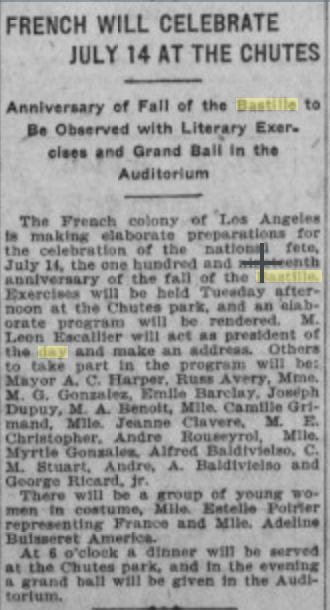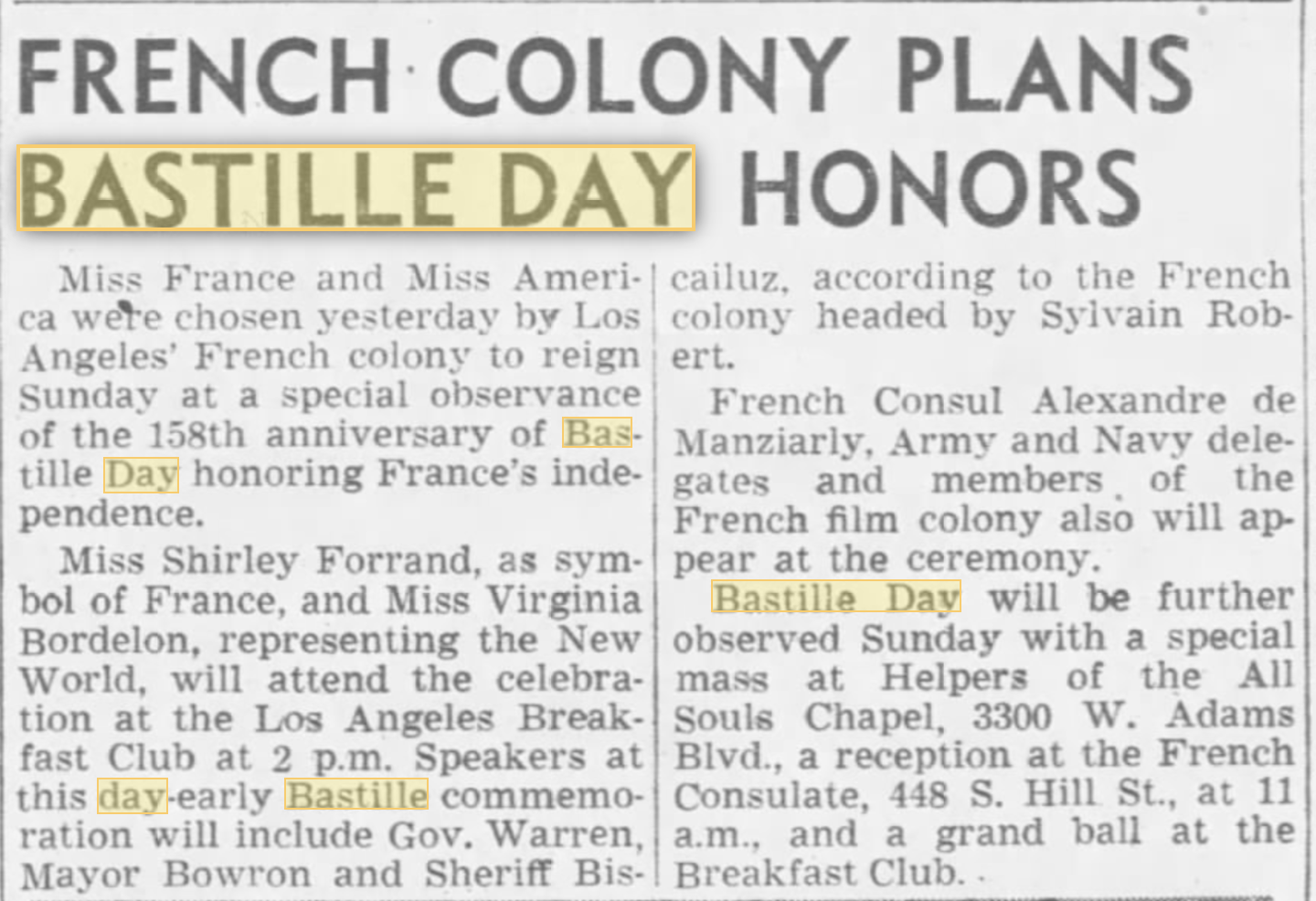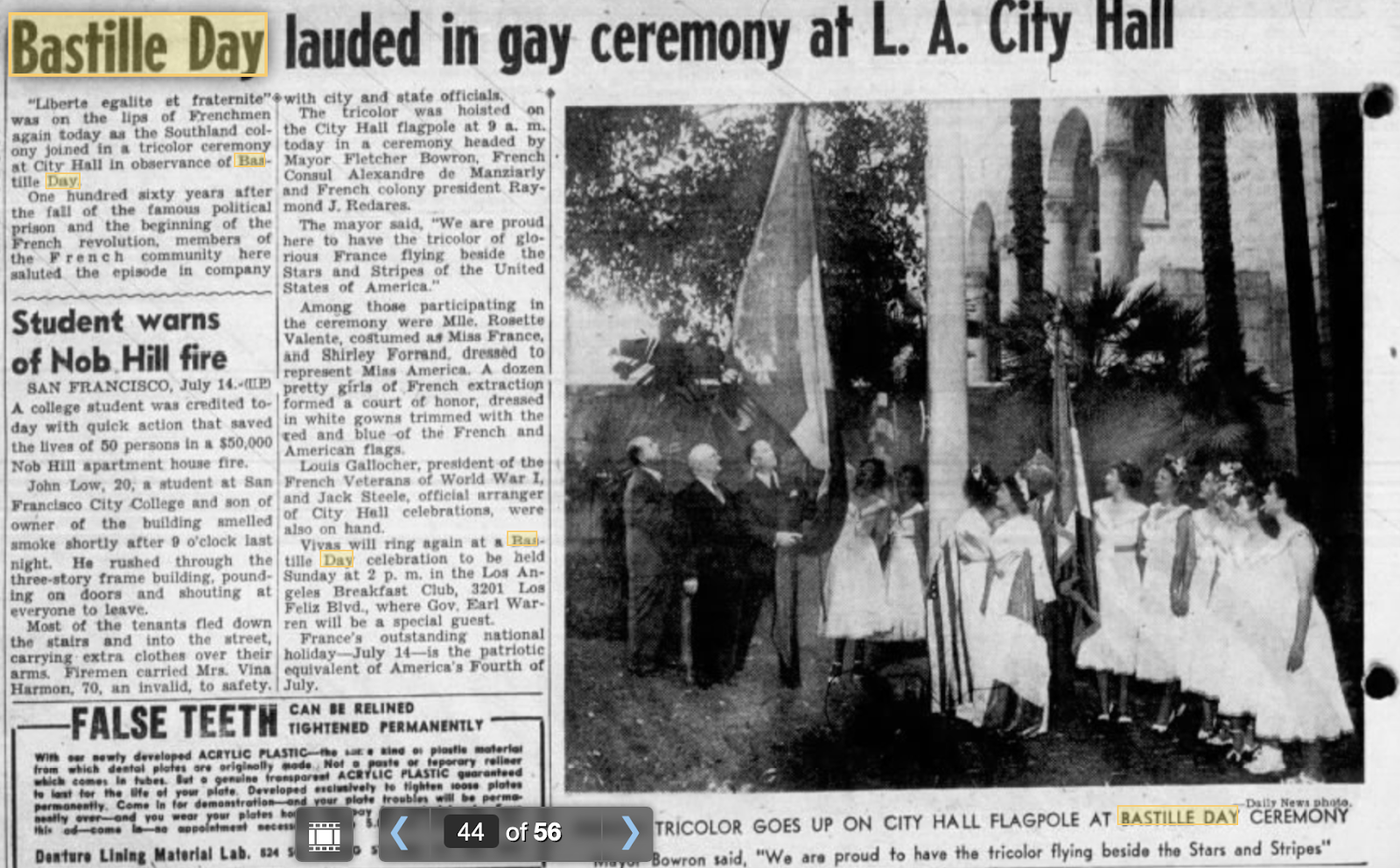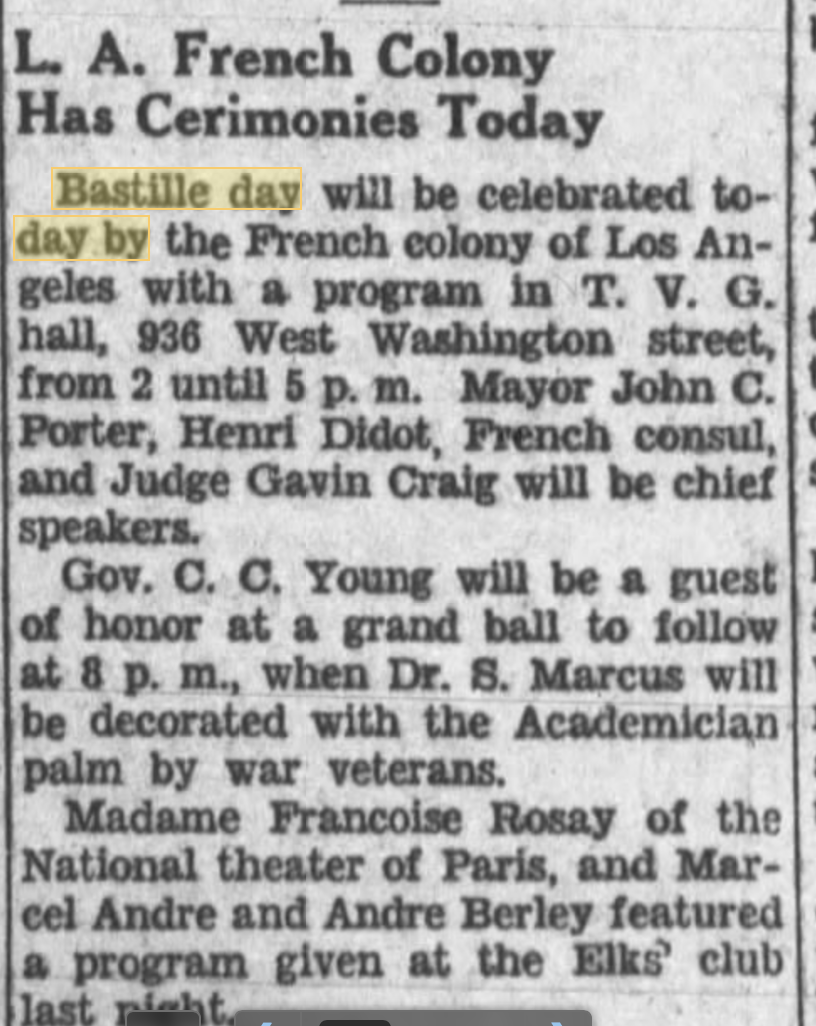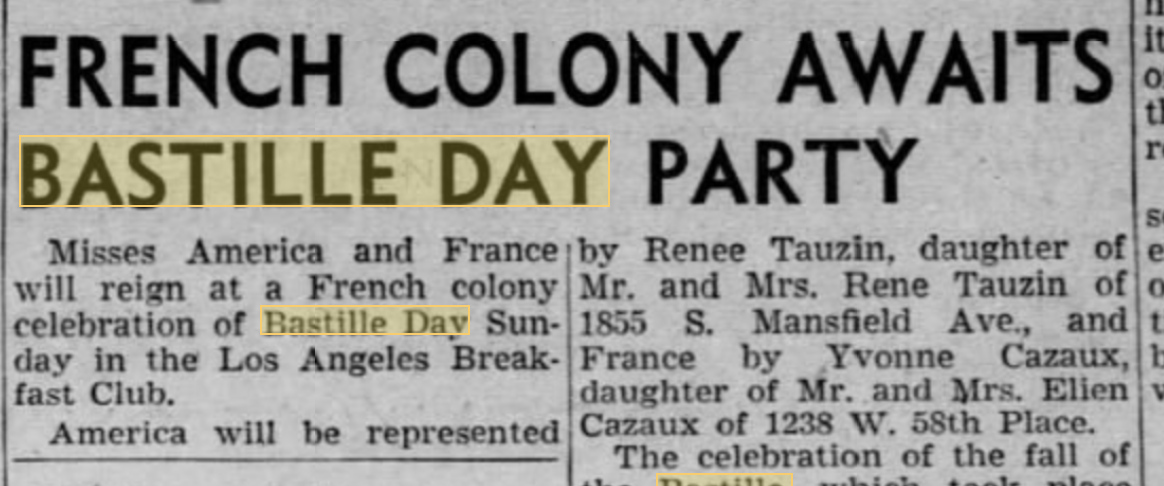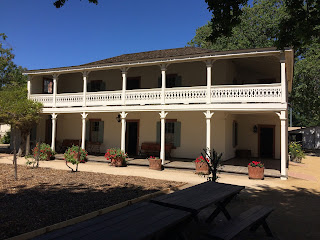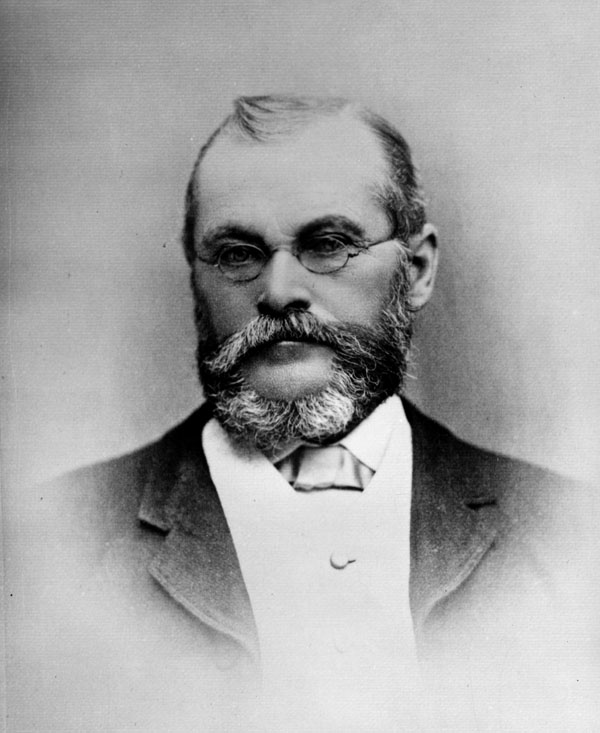Possessing boundless energy, exceptional
business sagacity and foresight, Prudent Beaudry amassed five fortunes
and lost four in his ventures, which were gigantic for that time, and
would be considered immense today.
-
Le Guide Francais, 1932
Have a seat, everyone...the lifetime I'm chronicling this week is best described as "epic".
Jean-Prudent
Beaudry was born July 24, 1816 in Mascouche, Quebec - close to
Montreal. When he was a young boy, the family moved to the neighboring town of
Saint-Anne-des-Plaines.
There were five Beaudry
brothers (and three Beaudry sisters). All of the Beaudry brothers worked hard and got rich, but Prudent, Jean-Louis, and Victor would make the history
books. (Victor, the only other Beaudry to settle in Los Angeles, will be
covered in another entry, because this one is going to be LONG.)
The
Beaudrys, an industrious family of traders, sent their
sons to good schools in Montreal and New York. Prudent and his brothers
had the benefits of a great education and English fluency when they went
into business for themselves.
Which they did, many times over.
Prudent
started out in his father's mercantile business, then went to work at a
different mercantile house in New Orleans, returning to Canada in 1842
to partner with one of his brothers. By 1844, he left the business to
join Victor, the youngest Beaudry brother, in San Francisco. The Gold
Rush was a few years away, but Victor had already established a
profitable shipping and commission business in the city. Before long,
the brothers were in the ice business (Victor later
partnered with another future mayor,
Damien Marchesseault, in distributing ice harvested in the San Bernardino Mountains). Perhaps not surprisingly for a native of Quebec, Prudent also
got into the syrup business. Two years later, after Prudent had lost
most of his money on real estate speculation (and more of it when
insufficiently insured stock was destroyed in a fire), Los Angeles
beckoned.
I'll let
Le Guide Francais take it from here:
Starting
with $1,100 in goods and $200 cash in a small store on Main Street,
where the City Hall now stands, it is said that he cleared $2,000 in
thirty days, which enabled him to take a larger store on Commercial
Street. From that time on, Prudent Beaudry was one of the preeminent men
of the economic, social, and political life of the Southwest.
(The book, just to clarify, refers to the
current City Hall, not the old Bell Block down the street. After Beaudry vacated the Commercial Street shop, Harris Newmark moved in. Ironically, Beaudry sold his dry goods business to Newmark twelve years later.)
Having
earned a well-deserved vacation, Prudent left Los Angeles for Paris in
1855. The chief items on his itinerary were seeing the
Exposition Universelle and consulting the great French oculist
Dr. Jules Sichel.
Prudent visited Montreal on his return trip to visit his brother
Jean-Louis, who would serve as Mayor of Montreal for a total of ten
years between 1862 and 1885. The Beaudrys, needless to say, were just as
prominent in business, politics, and society in Quebec as they were in
Southern California.
While Prudent was away, Victor was
capably managing his brother's business interests. Prudent had
purchased a building on the northeast corner of Aliso and Los Angeles
Streets in 1854 for $11,000. Victor spent $25,000 - an absolute fortune
at the time - on remodeling and improving the building. In this case, it
was money well spent. After the Beaudry Block was improved, it was
considered the finest building in Southern California for the time.
Rents increased from $300 per month to $1,000 per month.
Prudent
returned to Los Angeles in 1861 (Victor had been offered a contract to
supply the Army of the Potomac and found it difficult to manage his
brother's business interests at the same time). He continued in the
mercantile business until 1865. Due to stress, he retired...but not for long. The Beaudrys just weren't capable of being unproductive.
In 1867,
Prudent Beaudry made one of his greatest real estate investments. The
steep hill above New High Street, which he purchased at a Sheriff's
Department auction for the pittance of $55 (I can't believe it either),
was known as
Bunker Hill. It would soon become famous for its Victorian mansions.
This
purchase set Beaudry on a path that made him California's first realtor
and first large-scale developer, in addition to an urban planner.
Before long, he was buying extensive tracts of land, dividing them into
lots, and selling them, working out of an office opposite the Pico
House. One 20-acre tract, between Charity (Grand) and Hill from Second
to Fourth, cost $517 and netted $30,000. Another tract, consisting of 39
acres bordered by Fourth, Sixth, Pearl (Figueroa) and Charity (Grand),
earned $50,000.
The Beaudry brothers (smartly) kept
buying land. They predicted - correctly, and beyond their wildest dreams
- that after railroad lines connected Los Angeles to San Francisco and
the East Coast, new settlers would pour into Southern California in
droves. (If they could only see how right they were!) Prudent also
bought land in modern-day Arcadia and near the Sierra Nevada mountains
(building aqueducts to redirect mountain streams to his properties), and
helped to found the cities of Pasadena and Alhambra.
One
newspaper advertisement from 1873 lists 83 (yes, 83!) separate lots for
houses, in addition to two full city blocks, multiple city tracts, and
large land parcels in Rancho San Pedro, Verdugo Ranch, and the Warner
and de la Hortilla land grants. A similar ad from 1874 notes, in bold,
which of the streets with lots for sale had already had water pipes
installed. It's no wonder Beaudry was able to keep his real estate
business going every time he lost most (or all) of his money.
Severe flooding in January 1868 had undone nearly all of
Jean-Louis Sainsevain and
Damien Marchesseault's
hard work on the city's primitive water system. As a developer, Beaudry
was very concerned about improving the city for its residents. On July
22, 1868, a 30-year contract for the water system was granted to the
newly-established Los Angeles City Water Company. The three partners in
the Company were Dr. John Griffin, French-born businessman Solomon
Lazard, and, of course, Prudent Beaudry (most of the employees were also
of French extraction - chief amongst them, Charles Lepaon, Charles
Ducommun, and Eugene Meyer - more on them in the future).
The
Los Angeles City Water Company replaced Sainsevain and Marchesseault's
leaky wood pipes with 12 miles of iron pipes, and continued to regularly
make improvements on the water system until the contract expired 30
years later (the city purchased the system for $2 million - in 1898
dollars!). Although nothing could cancel out the previous water problems
or Marchesseault's tragic suicide, the city of Los Angeles finally had a
reliable water system that wouldn't turn streets into sinkholes. (If
you live in Los Angeles and you like having running water, thank a
Frenchman. Seriously, you guys owe us.)
You're probably wondering how Prudent
managed to supply water to his hilltop property. In those days, hills
weren't desirable places to build homes because water had to be
transported in barrels via trolley or other vehicle. The city water
company wasn't interested in solving the problem. But in case you
haven't noticed yet, Prudent was smart, resourceful, and didn't give up
easily. He knew that if running water was available, prospective
homeowners would be more
likely to consider hilltop lots and pay a good price for them. So he
constructed a huge reservoir and a pump system that supplied water from
LA's marshy lowlands to Bunker Hill. The pump system worked perfectly - and so did his plan. (I'll bet every land speculator in Southern California wished they had thought of that.)
Before
long, Bunker Hill became THE place to build grand homes. At least two
of its fabled Victorian mansions were built for other French Angelenos -
entrepreneur
Pierre Larronde and model citizen
Judge Julius Brousseau.
Let
it be known, however, that Beaudry developed for everyone. It's true
that he built mansions and had a keen interest in architecture, but he
also built modest homes on small lots for working families. And because he made modest properties available for small monthly payments, he made home ownership possible for buyers with lower incomes. He made considerable
improvements to his land - paving roads, planting trees, and providing
for water usage.
And Beaudry just kept developing land for the rest of his life.
This Lost LA article includes an 1868 map showing five tracts recently developed by Beaudry.
The Bellevue tract included a garden he dubbed "Bellevue Terrace". This
early park rose 70 feet above downtown, boasting hundreds of eucalyptus
and citrus trees. Beaudry eventually put the site up for sale. The State
of California bought it to develop a Los Angeles campus of the State
Normal School, which would later become UCLA. When UCLA moved to
Westwood in the 1920s, the hill was graded down and replaced with
Central Library.
A few miles away, where North Beaudry
Avenue meets Sunset Boulevard, there is an oval-shaped parcel of land
that currently holds a church, a restaurant, and The Elysian apartment
building. In the early 1870s, this was Beaudry Park - another garden
paradise on a hill, boasting citrus groves and eucalyptus trees (and
vineyards!). But the Beaudrys put it on the market a decade later. The
Sisters of Charity snapped it up in 1883, building a newer facility and
relocating St. Vincent's Hospital (sometimes called the Los Angeles
Infirmary) here.
Beaudry owned a large tract containing one block of
stagnant, foul-smelling marshland. No one wanted to build on the land,
and it wasn't ideally suited to
building anyway. In 1870, Beaudry got the idea to drain the marsh and turn the land
into a public park. Naturally, he spearheaded the plan.
Originally called Los Angeles Park, the land was renamed Central Park in the
1890s...and was renamed again later.
You know this
park. There's a good chance you've been there (and there's a VERY good
chance you absolutely hate its current incarnation).
Give up yet?
It's
Pershing Square. (It used to be a very nice park. Trust me on this.)
Beaudry's
dedication to developing, planning, and improving the city got him
started in politics. He was elected to the Los Angeles Common (City)
Council for three one-year terms (1871, 1872, and 1873). In 1873, he
became the first president of the city's new Board of Trade. His name
appeared in Los Angeles newspapers frequently throughout the 1870s and
1880s - mostly in the real estate sections (and in a bankruptcy
case...the Temple and Workman Bank failed and took most of his money
with it).
In 1874, Prudent Beaudry became Los Angeles' third French mayor, serving two terms. At the same time, his brother
Jean-Louis Beaudry was serving as mayor of Montreal.
After finishing his second term, Beaudry bought the local French-language newspaper,
L'Union. (I
will cover LA-based French newspapers - three or four are known to have
existed - at a later date.) Beaudry was already a director of the Los
Angeles City and County Printing and Publishing Company.
Nearly
all of Los Angeles' Victorian houses have been torn down over the
years. However, neighborhoods like Angelino Heights still have
Victorian-era homes. Guess who developed Angelino Heights? That's right -
Prudent and Victor Beaudry (architect Joseph Newsom designed many of the houses). Carroll Avenue, beloved by preservationists
for its high concentration of surviving Victorian homes (kitsch king
Charles Phoenix even includes it on his annual
Disneyland-themed DTLA tour as "Main Street USA"), is well within the original boundaries of Angelino Heights.
In
the 1880s, Angelino Heights was one of LA's earliest suburbs. Cars
would not be commonly used for quite some time. To serve the transit
needs of potential home buyers, the Beaudry brothers (with several other
real estate promoters) built the
Temple Street Cable Railroad.
This streetcar ran along Temple Street from Edgeware to Spring (it was
soon extended to Hoover Street) every ten minutes and ran for 16 hours
each day, making transportation fast and simple for residents of
Angelino Heights and Bunker Hill. The Pacific Electric Railway
eventually purchased the line (switching from cable cars to electric
trolleys in 1902), and in time it passed to the Los Angeles Railway. The
Temple Street Cable Railroad - far and away the most successful
streetcar line in the city's history - ran from 1886 to 1946. SIXTY
YEARS. Which is especially impressive considering the Pacific Electric
Railway didn't even exist until 1901, and its less-traveled streetcar
lines were converted to bus routes in 1925.
Funnily
enough, Beaudry had sued the Los Angeles Railway in 1891. He claimed the
Railway had excavated First and Figueroa Streets without the proper
authority, rendered the streets useless, and blocked access to his
property. (He also occasionally sued people who damaged his properties.
Can you blame the guy? Building a city is hard work.)
When
"Crazy Remi" Nadeau decided to liquidate most of his freighting
company's equipment, it was purchased by the Oro Grande Mining
Company...which counted Prudent and Victor Beaudry among its
shareholders. In the 1880s, the Beaudrys began to
take on fewer and fewer projects, but they both remained vocal
supporters of developing and improving Los Angeles.
Prudent
Beaudry passed away on May 29, 1893, a week after suffering a paralytic
stroke (Victor had passed away in 1888, with Prudent acting as executor
of his sizable estate).
An Illustrated History of Los Angeles County stated:
Prudent
Beaudry, in particular, has the record of having made in different
lines five large fortunes, four of which, through the act of God, or by
the duplicity of man, in whom he had trusted, have been lost; but even
then he was not discouraged, but faced the world, even at an advanced
age, like a lion at bay, and his reward he now enjoys in the shape of a
large and assured fortune. Of such stuff are the men who fill great
places, and who develop and make a country. To such men we of this later
day owe much of the beauty and comfort that surround us, and to such we
should look with admiration as models upon which to form rules of
action in trying times.
Beaudry died a wealthy
man (despite losing his fortune FOUR times), but ironically, he might
have died even wealthier. A 1905 article in the
Los Angeles Herald
stated that nearly forty years previously (i.e. in the 1860s), he had
begun to dig a well on one of his hilltop properties. After several
hundred feet, he struck a deposit that "looked and smelled like tar." He
promptly abandoned the half-dug well. That's right -
Beaudry struck oil.
But he wasn't looking for oil and had no use for it. Had he made the
same discovery a few decades later, things may have been a little
different.
The late Mayor's body was returned to his native Quebec. Like the rest of his family, he is buried at
Notre Dame des Neiges
(Canada's largest, and arguably most beautiful, cemetery). He never
married and had no children, so his estate went to the other Beaudry
siblings and their families.
Prudent Beaudry's
importance as an urban planner and city developer is almost completely
forgotten today. His work lingers in the names of Beaudry Avenue,
Bellevue Avenue, and various other French-named streets in tracts he
developed long ago. (Hill Street was once called Montreal Street in honor of the brothers' hometown - it isn't clear when it was renamed.)
(And, thankfully, Angelino Heights
is still standing. I will lose my last remaining shreds of faith in humanity if
something bad happens to those precious few surviving Victorians.)






